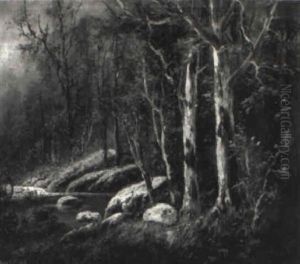Thomas G. Moses Paintings
Thomas G. Moses was an American artist, primarily known for his work as a scenic designer in the late 19th and early 20th centuries. Born in 1856, Moses became one of the most distinguished scenic artists of his time, working extensively for theaters across the United States.
Moses began his career in scenic design as an apprentice under the renowned scenic artist John Rettig in Cincinnati, Ohio. He quickly developed his skills and became recognized for his ability to create elaborate and realistic backdrops and settings for stage productions. His work was characterized by a keen attention to detail and a talent for creating depth and perspective, which brought stage environments to life for audiences.
Throughout his career, Moses worked with many of the leading theater companies of his day. He was particularly associated with the Chicago-based firm Sosman & Landis, which was one of the prominent scenic studios of the period. His designs graced the stages of both opera houses and vaudeville theaters, reflecting the varied entertainment tastes of the American public.
Beyond his theater work, Thomas G. Moses also contributed to the 1893 World’s Columbian Exposition in Chicago, which was a pivotal event in the history of American art and design. He was responsible for painting several large cycloramas, which are panoramic images on the inside of a cylindrical platform, designed to give viewers a 360-degree view of a particular scene.
Moses was not only a practitioner but also an educator, sharing his knowledge and skills with the next generation of scenic designers. He wrote a book titled 'Scenic Art and Stagecraft', which was published posthumously in 1935. This book remains a valuable resource for understanding the techniques and challenges of scenic design during the period.
Thomas G. Moses passed away in 1934, leaving behind a legacy of innovation and excellence in scenic design. His work had a significant impact on the visual aspects of theater production and set a high standard for realism and beauty in stagecraft that influenced future designers.









